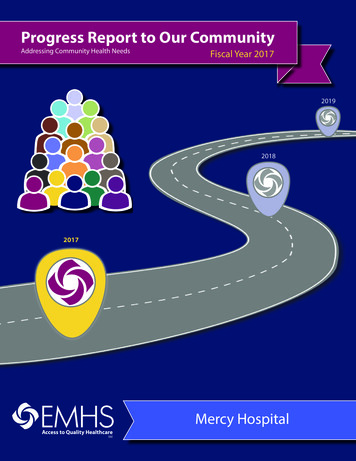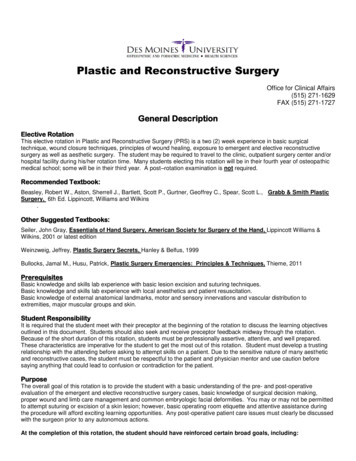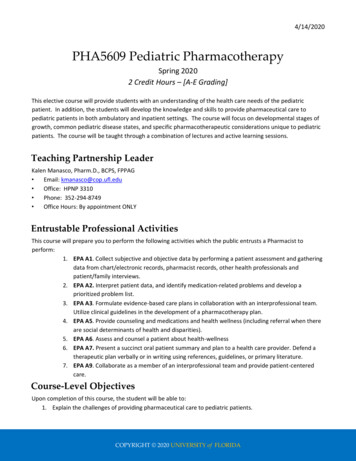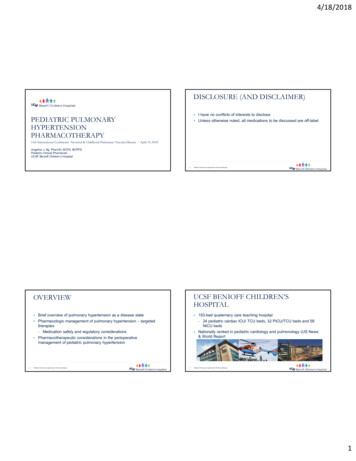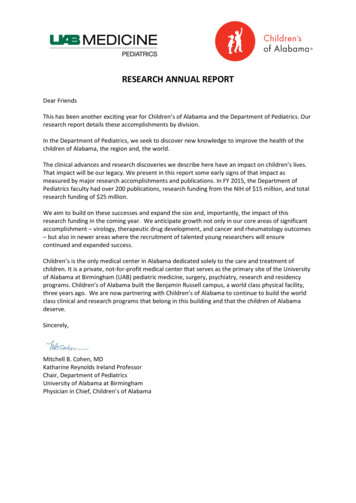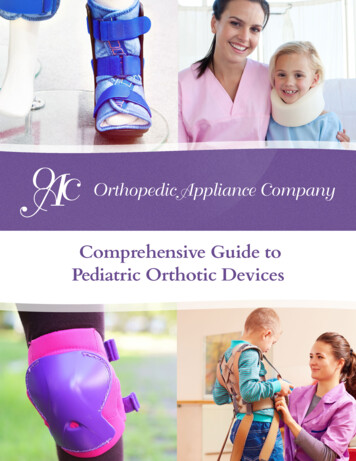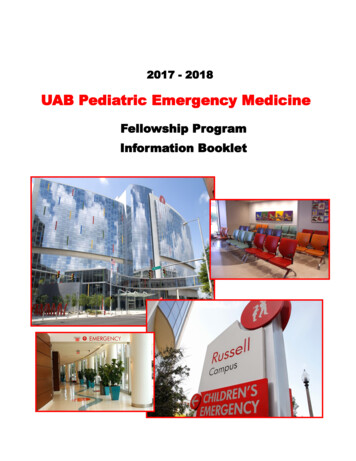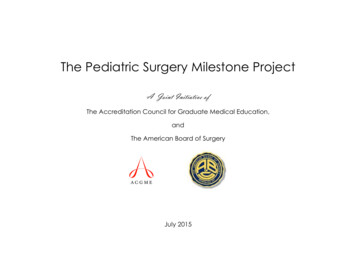
Transcription
The Pediatric Surgery Milestone ProjectA Joint Initiative ofThe Accreditation Council for Graduate Medical Education,andThe American Board of SurgeryJuly 2015
The Pediatric Surgery Milestone ProjectThe Milestones are designed only for use in evaluation of fellows in the context of their participation in ACGMEaccredited residency or fellowship programs. The Milestones provide a framework for assessment of thedevelopment of the fellow in key dimensions of the elements of physician competency in a specialty orsubspecialty. They neither represent the entirety of the dimensions of the six domains of physician competency,nor are they designed to be relevant in any other context.i
Pediatric Surgery MilestonesChair: Ron Hirschl, MDWorking GroupAdvisory GroupKenneth S. Azarow, MD, FACS, FAAPMary Brandt, MDLaura Edgar, EdD, CAEJ. Ted Gerstle, MD, FRCSC, FACS, FAAPKurt Heiss, MDWhit Holcomb, MDMax R. Langham Jr., MDGrace Z. Mak, MDMark V. Mazziotti, MDBenedict C. Nwomeh, MDDavid Powell, MDPeggy Simpson, EdDJohn Waldhausen, MDTimothy P. Brigham, MDiv, PhDJames C. Herbert, MDJohn R. Potts III, MDii
Milestone ReportingThis document presents milestones designed for programs to use in semi-annual review of fellow performance and reporting to theACGME. Milestones are knowledge, skills, attitudes, and other attributes for each of the ACGME competencies organized in adevelopmental framework from less to more advanced. They are descriptors and targets for fellow performance as a fellow movesfrom entry into fellowship through graduation. In the initial years of implementation, the Review Committee will examine Milestoneperformance data for each program’s fellows as one element in the Next Accreditation System (NAS) to determine whether fellowsoverall are progressing.For each period, review and reporting will involve selecting milestone levels that best describe a fellow’s current performance andattributes. Milestones are arranged into numbered levels. Tracking from Level 1 to Level 5 is synonymous with moving from noviceto expert in the subspecialty.Selection of a level implies that the fellow substantially demonstrates the milestones in that level, as well as those in lower levels(see the diagram on page v).Level 1: The fellow demonstrates milestones expected of an incoming fellow.Level 2: The fellow is advancing and demonstrates additional milestones, but is not yet performing at a mid-fellowship level.Level 3: The fellow continues to advance and demonstrate additional milestones, consistently including the majority ofmilestones targeted for fellowship.Level 4: The fellow has advanced so that he or she now substantially demonstrates the milestones targeted for fellowship. Thislevel is designed as the graduation target.Level 5: The fellow has advanced beyond performance targets set for fellowship and is demonstrating “aspirational” goalswhich might describe the performance of someone who has been in practice for several years. It is expected that onlya few exceptional fellows will reach this level.iii
Additional NotesLevel 4 is designed as the graduation target and does not represent a graduation requirement. Making decisions about readiness forgraduation is the purview of the fellowship program director. Study of Milestone performance data will be required before theACGME and its partners will be able to determine whether milestones in the first four levels appropriately represent thedevelopmental framework, and whether Milestone data are of sufficient quality to be used for high-stakes decisions.Examples are provided with some milestones. Please note that the examples are not the required element or outcome; they areprovided as a way to share the intent of the element.Some milestone descriptions include statements about performing independently. These activities must occur in conformity to theACGME supervision guidelines, as well as to institutional and program policies. For example, a fellow who performs a procedureindependently must, at a minimum, be supervised through oversight.Answers to Frequently Asked Questions about Milestones are available on the Milestones web tonesFAQ.pdf.iv
The diagram below presents an example set of milestones for one sub-competency in the same format as the ACGME ReportWorksheet. For each reporting period, a fellow’s performance on the milestones for each sub-competency will be indicated byselecting the level of milestones that best describes that fellow’s performance in relation to those milestones.Selecting a response box in the middle of alevel implies that milestones in that level andin lower levels have been substantiallydemonstrated.Selecting a response box on the line in between levelsindicates that milestones in lower levels have beensubstantially demonstrated as well as some milestonesin the higher level(s).v
01/2014THE PEDIATRIC SURGERY MILESTONES: ACGME REPORT WORKSHEETBronchoscopy/Esophagoscopy — Patient CareLevel 1Serves as first assistant forthe majority of theprocedureLevel 2EquipmentLimited ability to assemblescope and troubleshootfunctional problemsTechniqueLimited exposure oftracheobronchial tree andesophagus; poor utilizationof scopeForeign body/biopsyLimited ability to identifyforeign body/tumor or toretrieve foreign body/biopsytumorComments:Level 3Functional knowledgeadequate, but suboptimalassembly of equipment orability to troubleshootproblemsAdequate but suboptimalunderstanding and exposureof tracheobronchial tree andesophagus; adequateutilization of scopeAdequate but inefficientidentification of foreignbody/tumor and/or retrievalof foreign body/biopsy oftumorLevel 4Independent ability toassemble scope andtroubleshoot problemsLevel 5Develops innovative operativetechnique, approach, orsignificant improvement inbronchoscopy/esophagoscopyConsistently optimalunderstanding and exposureof tracheobronchial tree andesophagus; optimalutilization of scopeExpedient and safeidentification of foreignbody/tumor and/or retrievalof foreign body/biopsy oftumorNot yet achieved Level 1The Milestones are a product of the Pediatric Surgery Milestone Project, a Joint Initiative of the Accreditation Council for Graduate MedicalEducation and the American Board of Surgery.1
01/2014THE PEDIATRIC SURGERY MILESTONES: ACGME REPORT WORKSHEETEsophageal atresia/Tracheoesophageal Fistula (TEF) Repair — Patient CareLevel 1Serves as first assistant forthe majority of theprocedureLevel 2IncisionLimited ability to identifyappropriate incision or portplacementDissectionLimited ability to dissect TEFFistula ligationLimited ability toligate/divide fistula; concernfor tracheal narrowingAnastomosisLimited ability toappropriately space andplace anastomotic suturesand approximate tissueComments:Level 3Functional, but suboptimalincision or port placementLevel 4Consistently appropriateplacement of incision orportsLevel 5Develops innovativeoperative technique,approach, or significantimprovement in theestablished technique foresophageal atresia/TEFrepairAdequate but suboptimaldissection of TEFExpedient dissection, safeisolation of TEFSuccessful, but suboptimalligation/division of fistula andtracheal dissectionConsistently appropriateligation/division of fistula;maintained appropriate cuffof membranous tracheaOccasional lapses inappropriate spacing anddepth of anastomoticsutures, or occasional lapse intissue approximationConsistently appropriatespacing of sutures, tissueapproximation, andconsistent bites intosubmucosaNot yet achieved Level 1The Milestones are a product of the Pediatric Surgery Milestone Project, a Joint Initiative of the Accreditation Council for Graduate MedicalEducation and the American Board of Surgery.2
01/2014THE PEDIATRIC SURGERY MILESTONES: ACGME REPORT WORKSHEETInguinal hernia repair on a child less than six months of age — Patient CareLevel 1Serves as first assistant forthe majority of theprocedureLevel 2IncisionLimited ability to identifyappropriate incision or portplacementExposureLimited ability to expose keystructuresHernia sacdissection/ligationLimited ability to performhernia sac dissection/ligationor vas/vessel/fallopian tubedissectionComments:Level 3Functional but suboptimalplacement of incision/port(s)Level 4Consistently appropriateplacement of incision/port(s)Adequate establishment andmaintenance of retractionbut with occasional loss ofexposure of key structuresConsistently optimizesexposure of inguinalanatomy; efficiently directswound retraction tomaintain exposureSuccessful, but suboptimaldissection/ligation of herniasac; vas/vessels/fallopiantube preserved with minortraumatic injuryConsistently appropriatedissection/ligation of herniasac and consistently safemobilization ofvas/vessels/fallopian tubeLevel 5Develops innovativeoperative technique,approach, or significantimprovement in establishedtechnique for inguinal herniarepairNot yet achieved Level 1The Milestones are a product of the Pediatric Surgery Milestone Project, a Joint Initiative of the Accreditation Council for Graduate MedicalEducation and the American Board of Surgery.3
01/2014THE PEDIATRIC SURGERY MILESTONES: ACGME REPORT WORKSHEETIntestinal/duodenal atresia (DA) repair — Patient CareLevel 1Serves as first assistantfor the majority of theprocedureLevel 2Incision/port placementLimited ability to identifyappropriate incision or portplacementAbdominal explorationLimited ability to performabdominal exploration thatshould include evaluation foradditional abnormalities (e.g.,atresias, malrotation)Intestinal resection (atresia)Limited ability to performintestinal resection or failure toconsider need fortapering/Serial TransverseEnteroplasty (STEP)AnastomosisLimited ability to appropriatelyspace and place anastomoticsutures and approximate tissue(in DA, often unaware ofSphincter of Oddi)Comments:Level 3Functional but suboptimalplacement of incision/port(s)Level 4Consistently appropriateplacement of incision/port(s)Level 5Develops innovativeoperative technique,approach, or significantimprovement inestablished technique forintestinal/DA repairAdequate, but suboptimalperformance of abdominalexploration that should includeevaluation for additionalanomalies (e.g., atresias,malrotation)Consistently performscomplete, efficient, andsystematic abdominalexploration that identifiesadditional abnormalities (e.g.,atresias, malrotation)Adequate, but suboptimalperformance of intestinalresection and/or tapering/STEPConsistently appropriateunderstanding andperformance of intestinalresection and/or tapering/STEPOccasional lapses in spacingand depth of anastomoticsutures, or occasional lapse intissue approximation (in DA,occasional lapse in awarenessof Sphincter of Oddi)Consistently appropriatespacing of sutures, tissueapproximation, and consistentbites into submucosa (in DA,continually aware of Sphincterof Oddi)Not yet achieved Level 1The Milestones are a product of the Pediatric Surgery Milestone Project, a Joint Initiative of the Accreditation Council for Graduate MedicalEducation and the American Board of Surgery.4
01/2014THE PEDIATRIC SURGERY MILESTONES: ACGME REPORT WORKSHEETHirschsprung pull-through — Patient CareLevel 1Serves as first assistant forthe majority of theprocedureLevel 2Incision/port placementLimited ability to identifyappropriate incision or portplacementLevel 3Functional but suboptimalplacement of incision/port(s)Level 4Consistently appropriateplacement of incision/port(s)Adequate, but suboptimalperformance of abdominalexploration, identification oftransition zone, and/orperformance of biopsyConsistently performscomplete, efficient, andsystematic abdominalexploration with appropriateidentification of transitionzone and biopsyRectal dissection/resectionLimited ability to performpull-throughAdequate, but suboptimalperformance of pull-throughConsistently appropriateperformance of pull-throughSuture placementLimited ability toappropriately space andplace anastomotic sutures, orto approximate tissue;limited ability to orient pullthroughOccasional lapses in spacingand depth of anastomoticsutures, or lapses in tissueapproximation; occasionallapses in pull-throughsegment orientationConsistently appropriatespacing of sutures, tissueapproximation, and bitesinto submucosa; consistentlyaware of pull-throughsegment orientationAbdominal explorationLimited ability to performabdominal exploration or toidentify transition zoneand/or perform biopsyComments:Level 5Develops innovativeoperative technique,approach, or significantimprovement in establishedtechnique for Hirschsprungpull-throughNot yet achieved Level 1The Milestones are a product of the Pediatric Surgery Milestone Project, a Joint Initiative of the Accreditation Council for Graduate MedicalEducation and the American Board of Surgery.5
01/2014THE PEDIATRIC SURGERY MILESTONES: ACGME REPORT WORKSHEETWilms/Neuroblastoma Resection — Patient CareLevel 1Serves as first assistant forthe majority of theprocedureLevel 2Incision/port placement (asappropriate)Limited ability to identifyappropriate incision or portplacementAbdominal explorationLimited ability to performabdominal exploration/tumorexposureVascular controlLimited ability to identify andcontrol vascular structures ineither tumor, and/or to assessfor tumor thrombus in WilmsExcision of tumorLimited ability to safelymanipulate tumor (e.g.,without rupture in Wilms)and/or to make decisionsregarding resectabilityComments:Level 3Functional but suboptimalplacement of incision/port(s)Level 4Consistently appropriateplacement of incision/port(s)Adequate, but suboptimalperformance of abdominalexploration/tumor exposureConsistently performscomplete, efficient, andsystematic abdominalexploration/tumor exposureAdequate, but suboptimalperformance of control ofvascular structures in eithertumor, and/or assessment fortumor thrombus in WilmsConsistently appropriateperformance of control ofvascular structures in eithertumor, and assessment fortumor thrombus in WilmsAdequate, but suboptimalability to safely manipulatetumor (e.g., without rupturein Wilms) and/or to makedecisions regardingresectabilityConsistently appropriatetechnique with tumormanipulation and intraoperative decision-makingLevel 5Develops innovativeoperative technique,approach, or significantimprovement in establishedtechnique forWilms/neuroblastomaresectionNot yet achieved Level 1The Milestones are a product of the Pediatric Surgery Milestone Project, a Joint Initiative of the Accreditation Council for Graduate MedicalEducation and the American Board of Surgery.6
01/2014THE PEDIATRIC SURGERY MILESTONES: ACGME REPORT WORKSHEETCongenital Diaphragmatic Hernia Repair — Patient CareLevel 1Serves as firstassistant for themajority of theprocedureLevel 2Extracorporeal membraneoxygenation (ECMO) cannulation (ifperformed) decision makingLimited ability to make appropriatedecision for instituting ECMO anddiscriminating between venovenousand venoarterial optionsCannulationLimited ability to identify and controlcervical vascular structures; limitedability to safely insert cannulasIncision/port placementLimited ability to identify appropriateplacement of incision/port(s)Diaphragm repairLimited ability to safely andeffectively reduce hernia contentsand/or close diaphragmatic defectwith appropriately spaced/placedsuturesComments:Level 3Adequate, but suboptimaldecision-making for institutingECMO and discriminatingbetween venovenous andvenoarterial optionsLevel 4Consistently appropriatedecision-making for institutingECMO and discriminatingbetween venovenous andvenoarterial optionsAdequate, but suboptimalability to identify and controlneck vascular structures;adequate, but suboptimalability to safely insert cannulasConsistently appropriate abilityto identify and control neckvascular structures; consistentability to safely insert cannulasFunctional but suboptimalplacement of incision/port(s )Consistently appropriateplacement of incision/port(s)Adequate, but suboptimalability to effectively reducehernia contents and/or closediaphragmatic defect withappropriately spaced/placedsuturesConsistently demonstrates theappropriate ability toeffectively reduce herniacontents and/or closediaphragmatic defect withappropriately spaced/placedsuturesLevel 5Develops innovativeoperative technique,approach, or significantimprovement inestablished techniquefor congenitaldiaphragmatic herniarepairNot yet achieved Level 1The Milestones are a product of the Pediatric Surgery Milestone Project, a Joint Initiative of the Accreditation Council for Graduate MedicalEducation and the American Board of Surgery.7
01/2014THE PEDIATRIC SURGERY MILESTONES: ACGME REPORT WORKSHEETGeneral Procedure Assessment — Patient CareLevel 1Serves as first assistant forthe majority of theprocedureLevel 2Instrument handlingLimited ability to choose anduse instrumentsappropriatelyRespect for tissueLimited ability to handletissues carefully; moderatetissue damageTime and motionFrequent tentative, awkward,unnecessary movementsOperation flowFrequent lack of forwardprogression; frequently stopsoperating and seems unsureof next moveComments:Level 3Adequate, but suboptimaluse and choice ofinstrumentsLevel 4Consistently appropriate useand choice of instrumentsAdequate, but suboptimaltissue handling; occasionaltissue damageConsistently appropriatehandling of tissues; minimaltissue damageEfficient time and motion,occasional awkward orunnecessary movementsClear economy of motionand maximum efficiencySome forward planning ofoperation; reasonableprocedure progressionObviously has plannedcourse of operation andanticipated next stepsLevel 5Develops innovativeoperative technique,instrumentation, operativeapproach, or significantimprovement in establishedtechniqueNot yet achieved Level 1The Milestones are a product of the Pediatric Surgery Milestone Project, a Joint Initiative of the Accreditation Council for Graduate MedicalEducation and the American Board of Surgery.8
01/2014THE PEDIATRIC SURGERY MILESTONES: ACGME REPORT WORKSHEETGeneral Patient Care Assessment — Patient CareLevel 1Performs a basic physicalexam and understands themanagement and imagingin a newborn or child;performs primaryassessment and initiatesresuscitation of an injuredchildDiagnoses commoncomplicationsRecognizes normal growth,development, andexpected outcome aftertreatmentLevel 2Performs a comprehensivephysical exam, recognizesassociated anomalies, andprovides the pre- and postoperative management of anuncomplicated newborn orsingle-system injured child,including intensive care unit(ICU) care (ventilatormanagement, parenteralnutrition, fluids andelectrolytes)Manages common postoperative complicationsRecognizes variances ingrowth, development, andexpected outcome aftertreatmentComments:Level 3Provides the pre- and postoperative management of acomplicated newborn, ormultiple injured child,including ICU care (ventilatormanagement, parenteralnutrition, fluids andelectrolytes)Manages complex postoperative complicationsEvaluates and managesvariances from expectedoutcomes in the late postoperative course in theoutpatient settingLevel 4Directs the multidisciplinarypre- and post-operativemanagement of a complexnewborn with multipleanomalies, or multipleinjured child, including ICUcare (ventilatormanagement, parenteralnutrition, fluids andelectrolytes)Level 5Appropriately andindependently counselsfamilies for prenatal surgicalconditionsIndependently anticipates,diagnoses, and proficientlymanages interventions andcomplications, andappropriately involves themultidisciplinary teamCoordinates/leads amultidisciplinary team inproviding comprehensivecare of the childtransitioning to adulthoodDirects and leadsmultidisciplinary team inquality improvementfocused on patientoutcomesIndependently providescomprehensive long-termcare in the outpatientsettingNot yet achieved Level 1The Milestones are a product of the Pediatric Surgery Milestone Project, a Joint Initiative of the Accreditation Council for Graduate MedicalEducation and the American Board of Surgery.9
01/2014THE PEDIATRIC SURGERY MILESTONES: ACGME REPORT WORKSHEETMedical KnowledgeLevel 1Through discussion indidactic and clinical settings,this fellow demonstratesthorough knowledge of thebasic pediatric surgery topicsbelow: AppendicitisInguinal herniaIntussusceptionMalrotationPyloric stenosisThoracic/abdominaltraumaUndescended testisLevel 2Through discussion in didacticand clinical settings, thisfellow demonstratesthorough knowledge of theintermediate pediatricsurgery topics below: Branchial cleftcyst/sinus/remnantGastroesophageal refluxGastroschisisLung physiologyOmphaloceleOvarian/adnexal diseasesLevel 3Through discussion indidactic and clinicalsettings, this fellowdemonstrates thoroughknowledge of the advancedpediatric surgery topicsbelow:Level 4Through discussion indidactic and clinicalsettings, this fellowdemonstrates thoroughknowledge of the complexpediatric surgery topicsbelow: DAECMOHirschsprung diseaseIntestinal atresiaNeuroblastomaWilms tumor Comments:Level 5Demonstrates expertisein specific area(s) ofpediatric surgery, and/orcontributes substantiallyto the literatureAnorectalmalformationBiliary atresiaCholedochal cystCongenitaldiaphragmatic herniaCystic pulmonaryairway malformationEsophageal atresiawith or without TEFNot yet achieved Level 1Demonstration of knowledge of topics can be evaluated through tools such as: 1) PedScore modules; 2) multiple choice questions; and 3)discussion of open-ended questions with faculty members.The Milestones are a product of the Pediatric Surgery Milestone Project, a Joint Initiative of the Accreditation Council for Graduate MedicalEducation and the American Board of Surgery.10
01/2014THE PEDIATRIC SURGERY MILESTONES: ACGME REPORT WORKSHEETGeneral Knowledge Assessment — Medical KnowledgeLevel 1Demonstrates knowledge ofembryology, anatomy, andphysiology of basic topicsDiscusses initial diagnosticand treatmentrecommendations for basictopics, including those thatrequire urgent managementDiscusses potentialcomplications and theirmanagement, as well asexpected outcomes forbasic topicsComments:Level 2Demonstrates knowledge ofembryology, anatomy, andphysiology of intermediatetopicsDiscusses initial diagnosticand treatmentrecommendations forintermediate topics, includingthose that require urgentmanagementDiscusses potentialcomplications and theirmanagement, as well asexpected outcomes forintermediate topicsLevel 3Level 4Demonstrates knowledge ofDemonstrates knowledge ofembryology, anatomy, andembryology, anatomy, andphysiology of advanced topics physiology of complex topicsDiscusses initial diagnosticand treatmentrecommendations foradvanced topics, includingthose that require urgentmanagementDiscusses initial diagnosticand treatmentrecommendations forcomplex topics, includingthose that require urgentmanagementDiscusses potentialcomplications and theirmanagement, as well asexpected outcomes foradvanced topicsDiscusses potentialcomplications and theirmanagement, as well asexpected outcomes forcomplex topicsLevel 5Demonstrates significantcommand of the literature,including novel therapeuticinterventions andoutcomesNot yet achieved Level 1The Milestones are a product of the Pediatric Surgery Milestone Project, a Joint Initiative of the Accreditation Council for Graduate MedicalEducation and the American Board of Surgery.11
01/2014THE PEDIATRIC SURGERY MILESTONES: ACGME REPORT WORKSHEETHealthcare Delivery and Cost – Systems Based PracticeLevel 1Understands costimplications of clinicaldecisionsLevel 2Articulates risk-benefitanalysis, including cost topatientLevel 3Incorporates costconsiderations into clinicaldecisionsLevel 4Leads efforts to reduce costsby reducing variations incareUnderstands how toappropriately utilize midlevel and other health careproviders to optimize thedelivery of care to children(inpatient, outpatient, oncall, rounding)Incorporates riskmanagement in pediatricsurgeryUnderstands the principles ofinsurance coverage andaccess to care for childrenUnderstands the concept ofwork relative value units(RVUs) and physiciancompensationLevel 5Develops or institutes a costefficient clinical pathwaywhich reduces cost ofpatient careAdvocates on a national orregional level for health carepolicyComments:The Milestones are a product of the Pediatric Surgery Milestone Project, a Joint Initiative of the Accreditation Council for Graduate MedicalEducation and the American Board of Surgery.12
01/2014THE PEDIATRIC SURGERY MILESTONES: ACGME REPORT WORKSHEETPatient Safety — Systems-based PracticeLevel 1Demonstrates anunderstanding of theimportance of patientsafety and the occurrenceof medical errors inpediatric surgery patientsParticipates in an effectivepatient hand-off andsurgical time-out processComments:Level 2Recognizes medical errorsas systemic events andfacilitates reporting in ablame-free environmentAnticipates the inherent riskof medical errors as a resultof inadequate patient handoff and surgical time-outLevel 3Suggests improvements toreduce medical errorsAnticipates potentiallydangerous situations andintervenesLevel 4Leads multidisciplinaryefforts to improve patientsafety at the division and/orhospital levelLevel 5Participates as an advocateon a regional or nationallevel for pediatric patientsafetyDesigns evidence-basedclinical pathway todecrease medical errorsNot yet achieved Level 1The Milestones are a product of the Pediatric Surgery Milestone Project, a Joint Initiative of the Accreditation Council for Graduate MedicalEducation and the American Board of Surgery.13
01/2014THE PEDIATRIC SURGERY MILESTONES: ACGME REPORT WORKSHEETSystems-based Documentation — Systems-based PracticeLevel 1Demonstrates commitmentto maintaining medicalrecordsComments:Level 2Accurately and promptlydocuments daily patient carewithin the institutionaldocumentation systemLevel 3Effectively uses medicalrecord system to synthesizecomplex patient informationLevel 4Effectively uses medicalrecord system to answer aclinical research question orcomplete a qualityimprovement projectLevel 5Works with the electronicmedical record professionalteam to solve problems inthe medical record systemNot yet achieved Level 1The Milestones are a product of the Pediatric Surgery Milestone Project, a Joint Initiative of the Accreditation Council for Graduate MedicalEducation and the American Board of Surgery.14
01/2014THE PEDIATRIC SURGERY MILESTONES: ACGME REPORT WORKSHEETEvidence-based Medicine — Practice-based Learning and ImprovementLevel 1Incorporates evidencebased guidelines intoclinical decisionsComments:Level 2Understands the quality andlimitations of availableliterature and dataLevel 3Synthesizes a clinical planfrom multiple sources ofevidenceLevel 4Demonstrates utilization ofevidence derived from adatabase or registry inchanging his or her practicepatternLevel 5Formulates an outcomesbased quality improvementproject to answer a clinicalquestionNot yet achieved Level 1The Milestones are a product of the Pediatric Surgery Milestone Project, a Joint Initiative of the Accreditation Council for Graduate MedicalEducation and the American Board of Surgery.15
01/2014THE PEDIATRIC SURGERY MILESTONES: ACGME REPORT WORKSHEETSelf-directed Learning — Practice-based Learning and ImprovementLevel 1Takes responsibility foractions and acknowledgeserrorsDirects the discussion atmorbidity and mortalityconference with anunderstanding of theseverity of the complicationpresented (e.g., selectscases to be presented,performs appropriateliterature search)Comments:Level 2Committed to selfimprovement; responds wellto feedbackLevel 3Is self-reflective about ownacademic, professional, andpersonal needs, strengths,and limitationsLevel 4Analyzes and interprets ownexperience, and uses theliterature to alter practicepatternLevel 5Displays a commitment tolifelong learning (e.g.,routinely surveys literature,engages in continuingmedical education [CME]activities, actively publishes)Not yet achieved Level 1The Milestones are a product of the Pediatric Surgery Milestone Project, a Joint Initiative of the Accreditation Council for Graduate MedicalEducation and the American Board of Surgery.16
01/2014THE PEDIATRIC SURGERY MILESTONES: ACGME REPORT WORKSHEETIntegrity — ProfessionalismLevel 1Demonstrates anunderstanding of the basiccognitive and ethicalcomponents ofprofessionalismDemonstratesfundamental aspects ofmedical professionalism,including confidentiality,respect for patient choice,citizenship (e.g., medicalrecord completeness,timeliness, arrives on timefor work, etc.), andindividual responsibility tothe teamComments:Level 2Thinks like a professional bydemonstrating behavioraland social components ofprofessionalismDemonstrates compassionand empathy for patients;his or her work is noted forintegrity, responsibility,commitment, and reliabilityunder most circumstancesLevel 3Acts like a professional whorecognizes limitations,accepts feedback, and iseffective at managingdifficult clinical situationsDemonstrates integrity,altruism, and individualresponsibility to thepatient, family, and teamunder all circumstances;serves as an advocate forquality patient careLevel 4Leads as a professional bymanaging him- or herselfand his or her team andpatientsServes as a role model forhonesty, integrity, andprofessionalism; patientneeds supersede selfinterestLevel 5Mentors others in areas ofprofessionalismMentors and teachesintegrity, altruism,individual responsibility,and professionalismUnderstands the ethicalimplications ofincorporating new surgicalskills and techniques intopracticeNot yet achieved Level 1The Milestones are a product of the Pediatric Surgery Milestone Project, a Joint Initiative of the Accreditation Council for Graduate MedicalEducation and the American Board of Surgery.17
01/2014THE PEDIATRIC SURGERY MILESTONES: ACGME REPORT WORKSHEETRecognition of Limits — ProfessionalismLevel 1Overestimates ability;rarely asks for
For each period, review and reporting will involve selecting milestone levels that best describe a fellow’s current performance and attributes. Milestones are arranged into numbered levels. Tracking from Level 1 to Level 5 is synonymous with moving from novice . Education and the American



